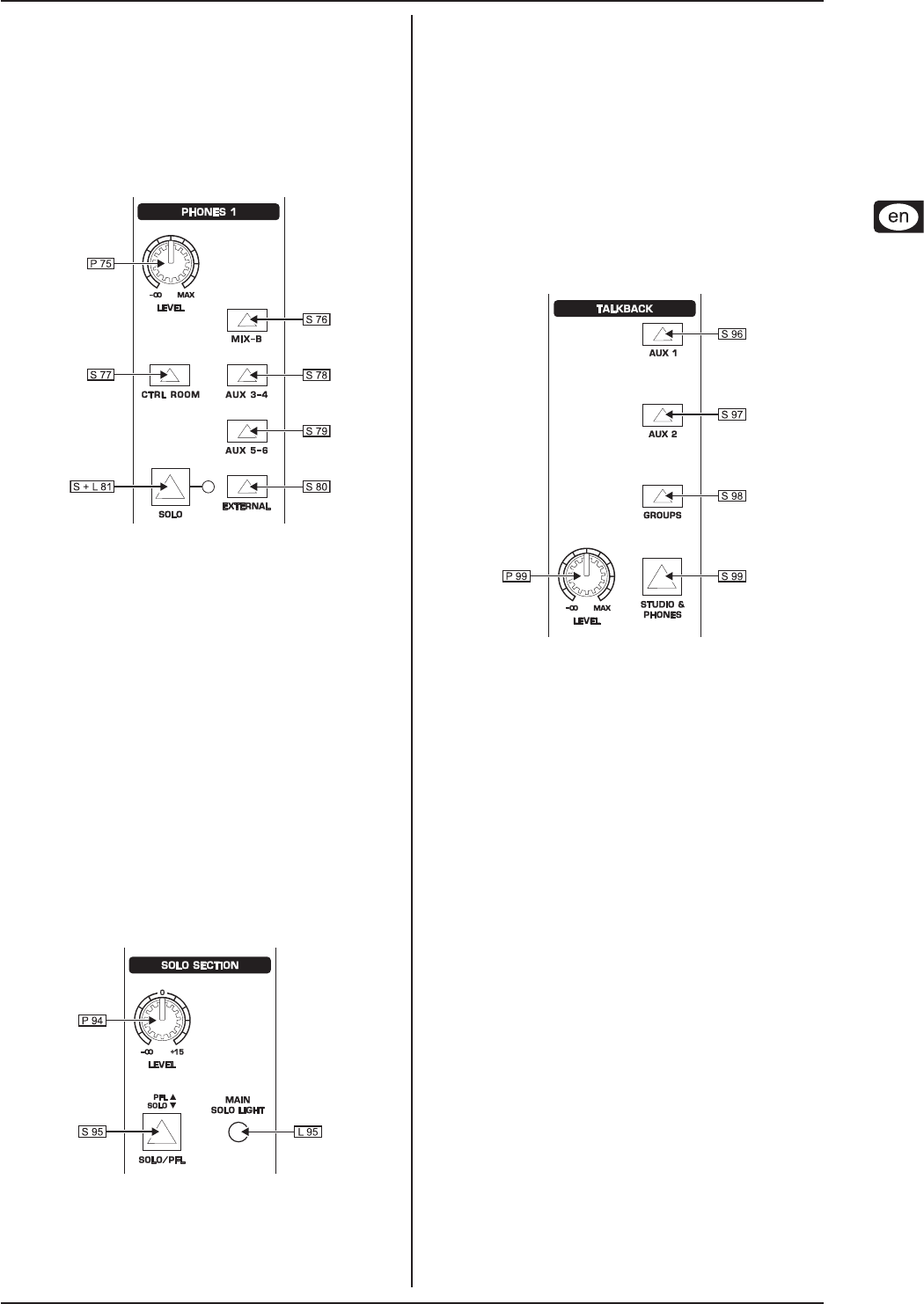
EURODESK SX4882
Master panel 11
If you are using the STUDIO output to drive a pair of +
monitors actually in the studio, do not ever leave P82
turned up during a take. Howls and howlround may well
be the result.
Lastly, there is a MONO button (S86), useful for checking the phase
correlation and/or coherence of a stereo signal. Again, this does
not affect the main mix output.
Headphones6.4
Both HEADPHONES 1 & 2 masters are identical.
PhonesFig. 6.5:
A SOURCING matrix picks up any or all of MIX-B (S76), CONTROL
ROOM (as chosen in monitor section, S77), AUX 3/4 (S78), AUX
5/6 (S79) and EXTERNAL (S80). In addition to the sources which
are directly selectable from the headphones masters, aux returns
3 to 6 may be “force-fed” into HP1 & HP2 from the aux returns
masters (S55, S56, etc.).
The headphone mix level is controlled by a master volume pot
(P75), and the gain is sufcient to drive headphones directly.
This is ne for a MIDI suite with overdub booth, but for the big-
ger studio’s headphone network we’d recommend using a
separate headphones distribution amplier like our BEHRINGER
POWERPLAY PRO HA4400. This can offer the added advantage
of independent headphones level control for every performer.
A SOLO button (S81), with its own LED, enables monitoring of
the headphones amplier’s output signal.
This way the engineer can monitor what’s going on in the cans
on the control room monitors, though in our experience this does
not give as true a picture as auditioning the cue feed from a set of
headphones identical to those worn by the performer(s).
PFL/SOLO6.5
Solo sectionFig. 6.6:
PFL6.5.1
Pressing S95 disengages the stereo SOLO bus, and replaces it
with a separate mono PFL (Pre-Fader-Listen) bus. Now anything at
all which is SOLOed, isn’t. It is PFLed instead. PFL should be used
for gain-setting. (See also the essential section 13 “Start-up”.)
SOLO6.5.2
SOLO is short for SOLO IN PLACE, and is the preferred method
for auditioning an isolated signal or a group of signals. Whenever
a SOLO button is pressed, all unselected channels are muted
in the monitors. Stereo panning is maintained. The SOLO bus
is derived from the output of the channel PANs, aux send/return
pots, etc., and is always post fader.
In addition to any local solo LEDs which might be activated, the
ultra-bright MAIN SOLO LED (L95) illuminates whenever anything
is SOLO/PFLed. P94 controls the master SOLO/PFL level. Set to
unity gain (center detente), this will match the mix level.
Talkback6.6
TalkbackFig. 6.7:
The built in mic (above the main mix faders) allows you to converse
with artists remotely. The most important controls are the VOLUME
(P99) and PHONES & STUDIO button (S99, see g. 6.7). It is
possible to route the talkback mic to any of the following: aux 1,
aux 2, subgroups, and phones and studio (S96 to S99).
Complex headphone or stage monitoring networks could be
constructed where HP1, HP2, aux 1 (pre), aux 2 (pre) and one or
more subgroups all feed separate monitor mixes. (See section 16.2
“Very tricky headphones”).
However, since the four pushbuttons are non-latching it might drive
you crazy. If you are using many headphone feeds, you may nd
it easier to patch a separate microphone for talkback straight into
a channel, where it can be routed pretty much anywhere.
Engaging TALKBACK (S99) dims the control room (monitors, not
lights) by -20 dB to restrict the possibility of feedback. All other
talkback routes are unaffected.


















